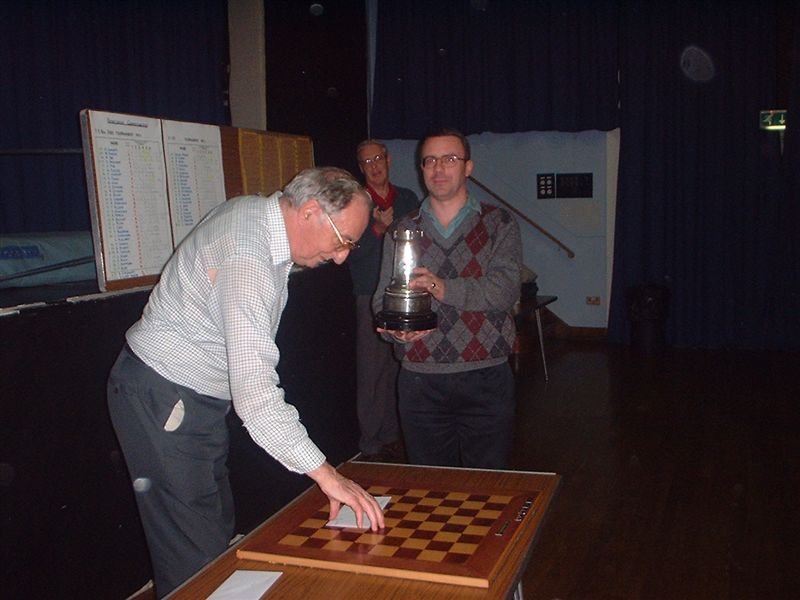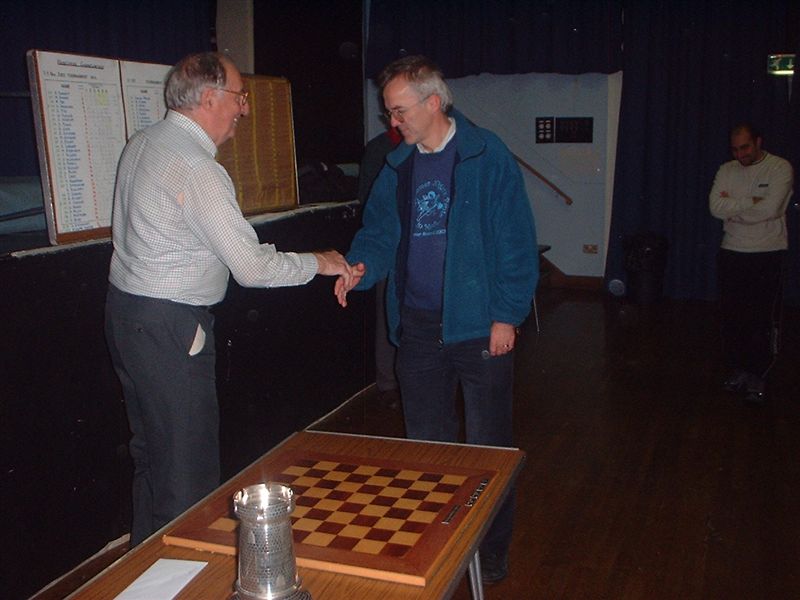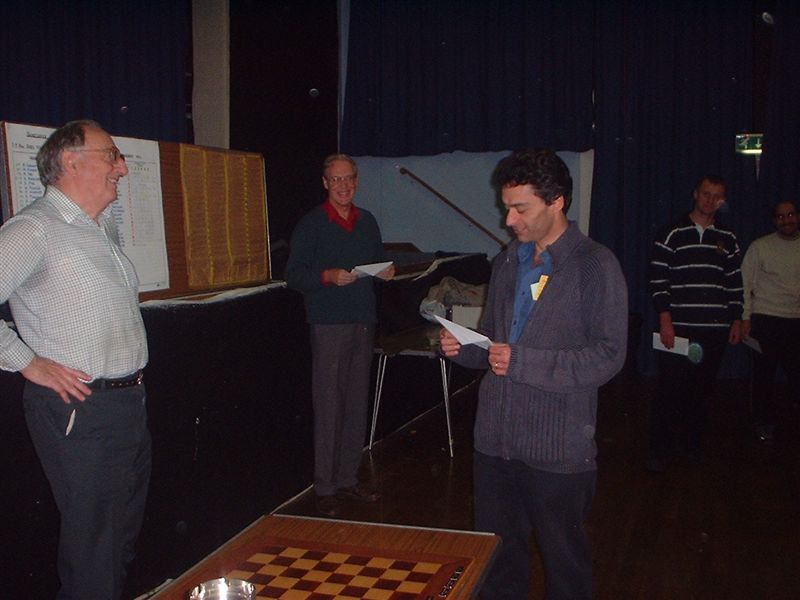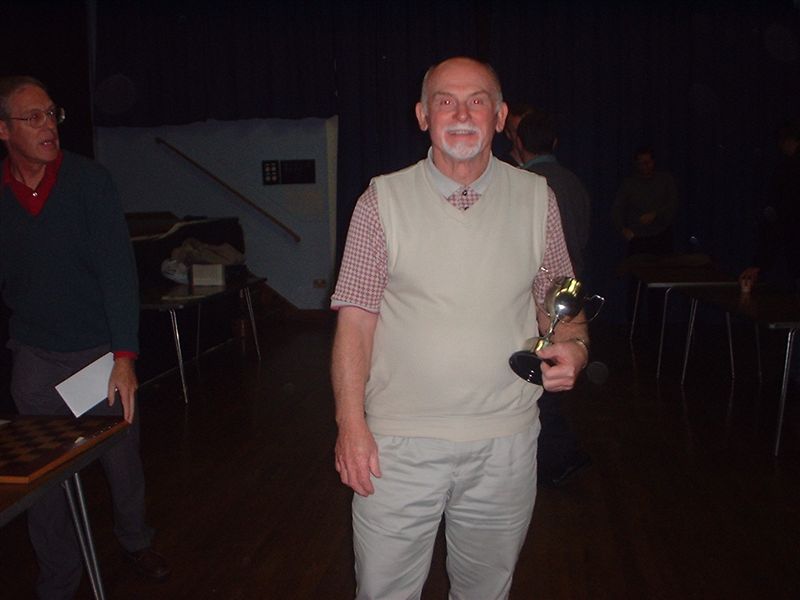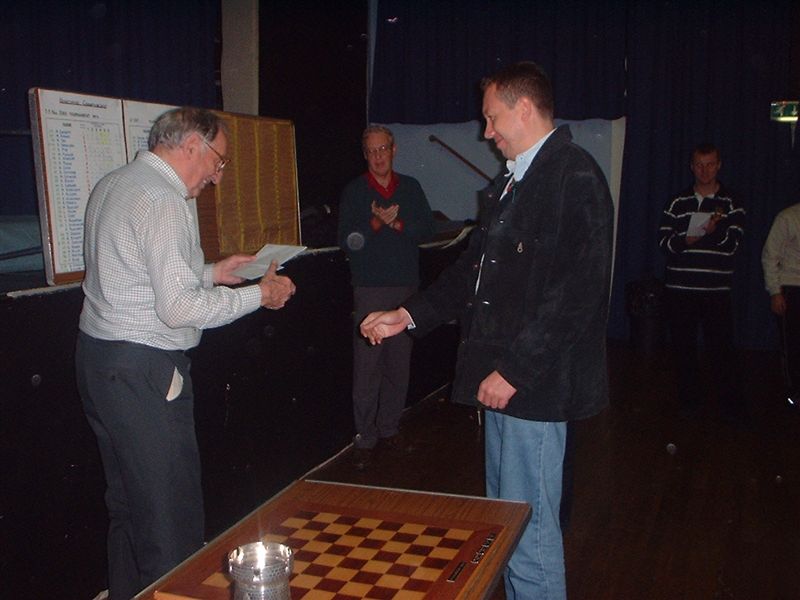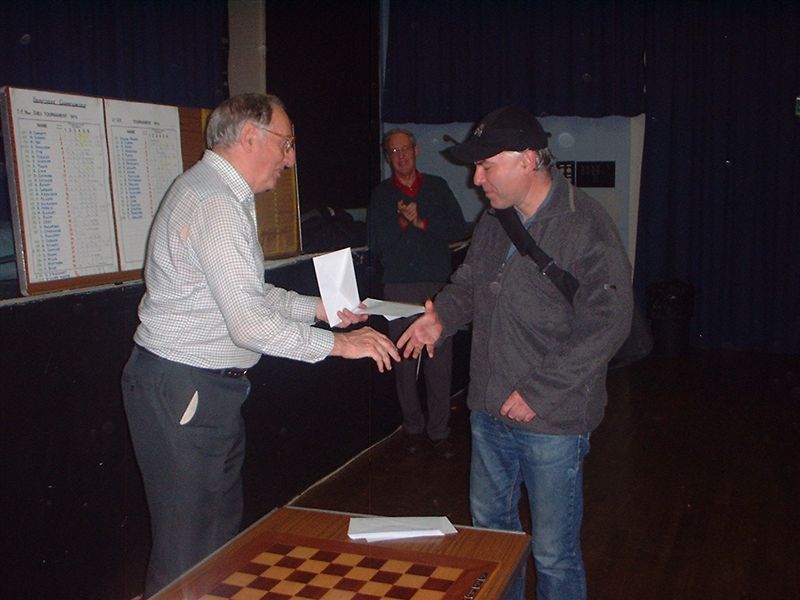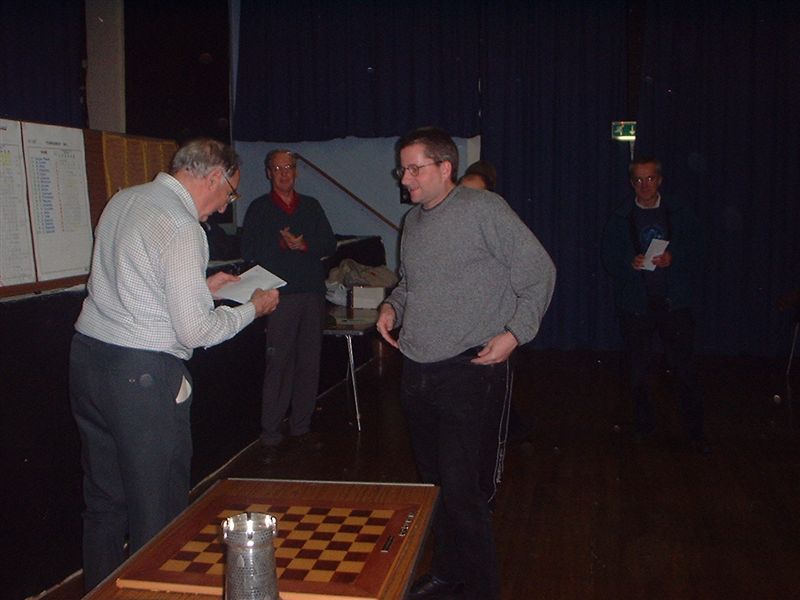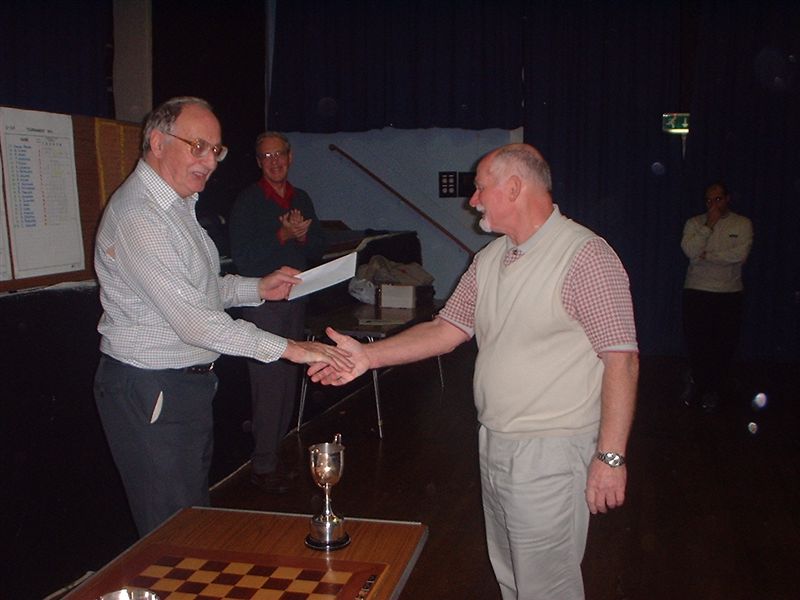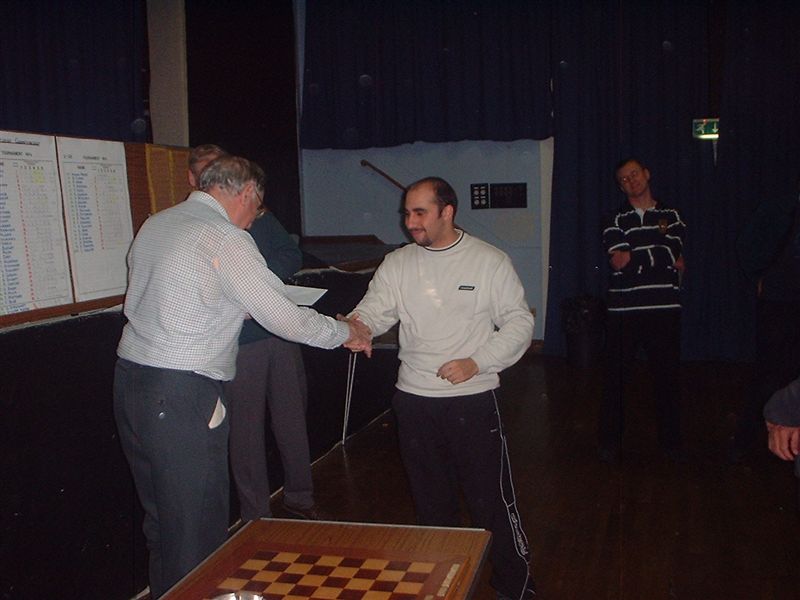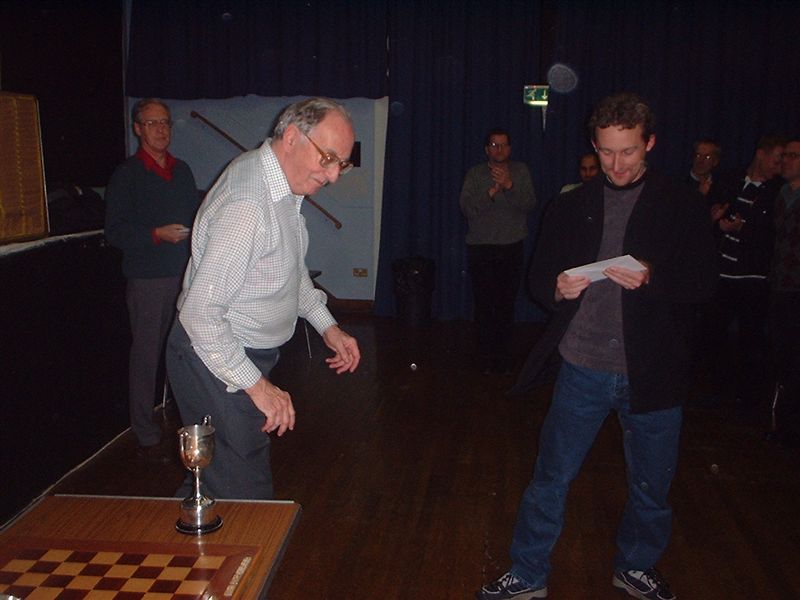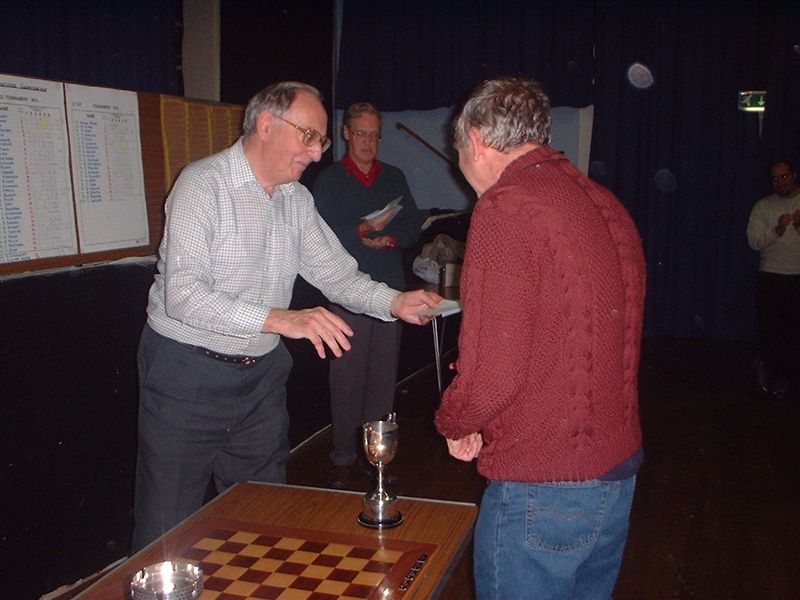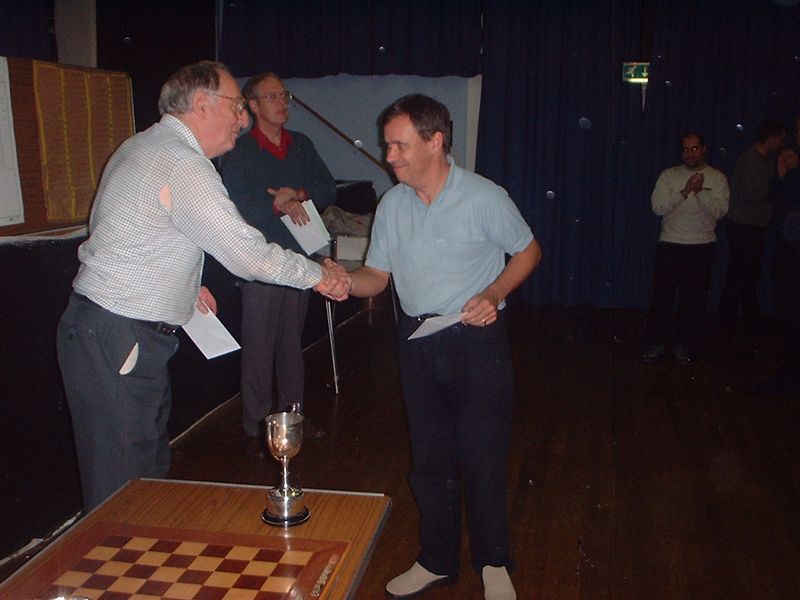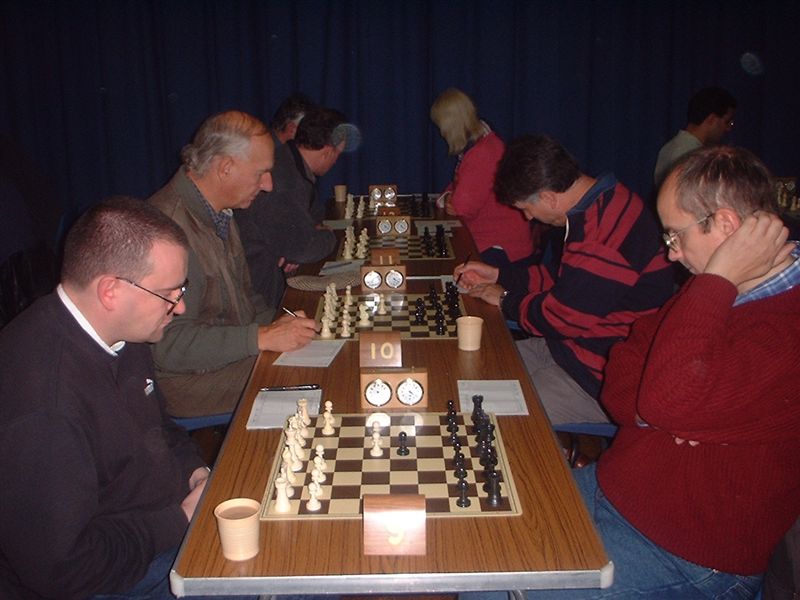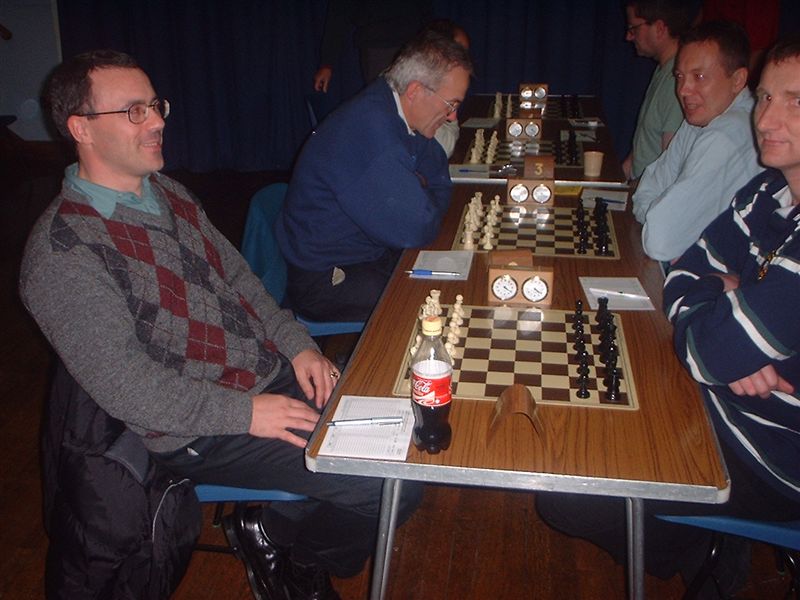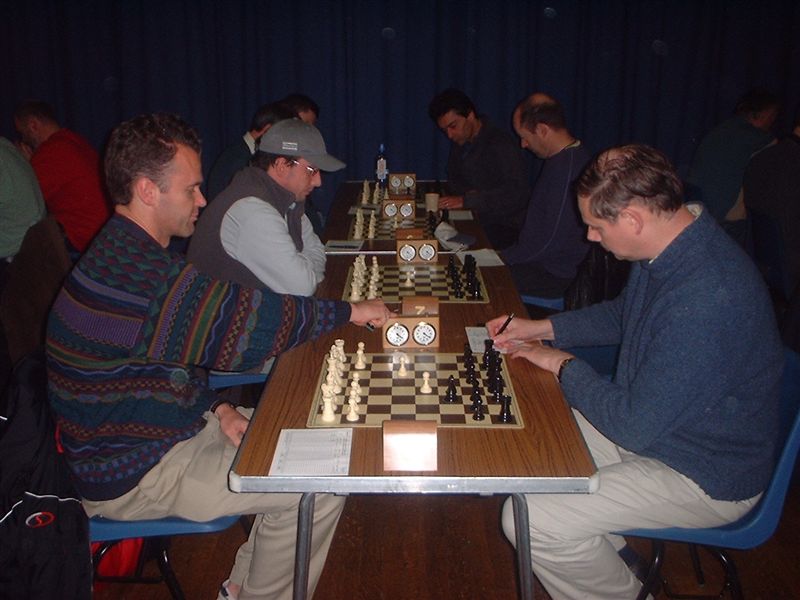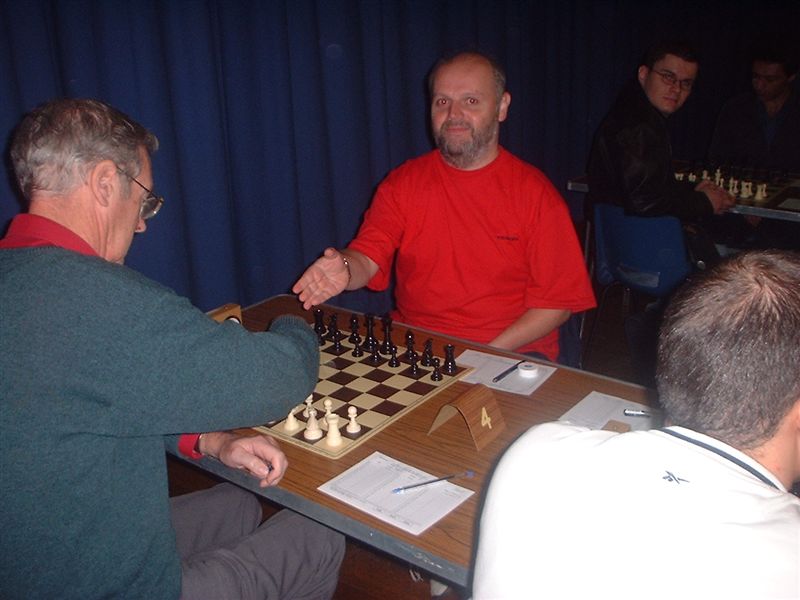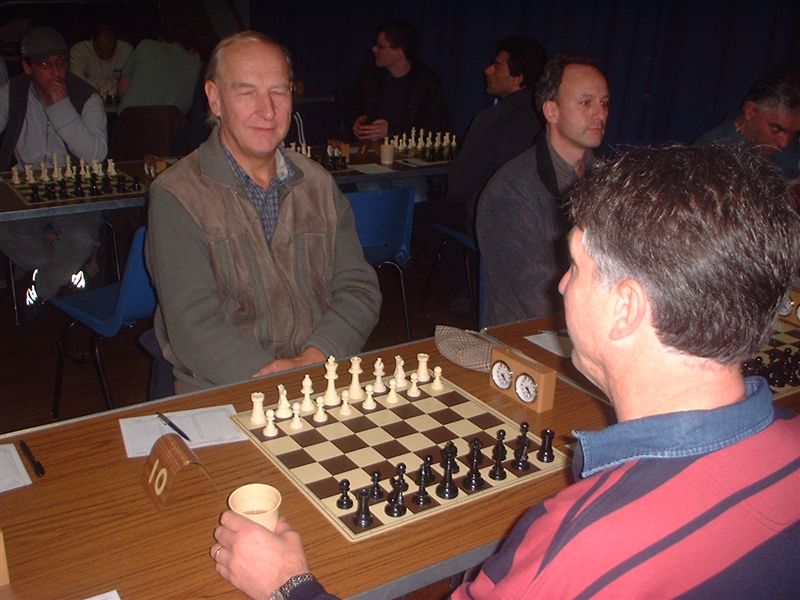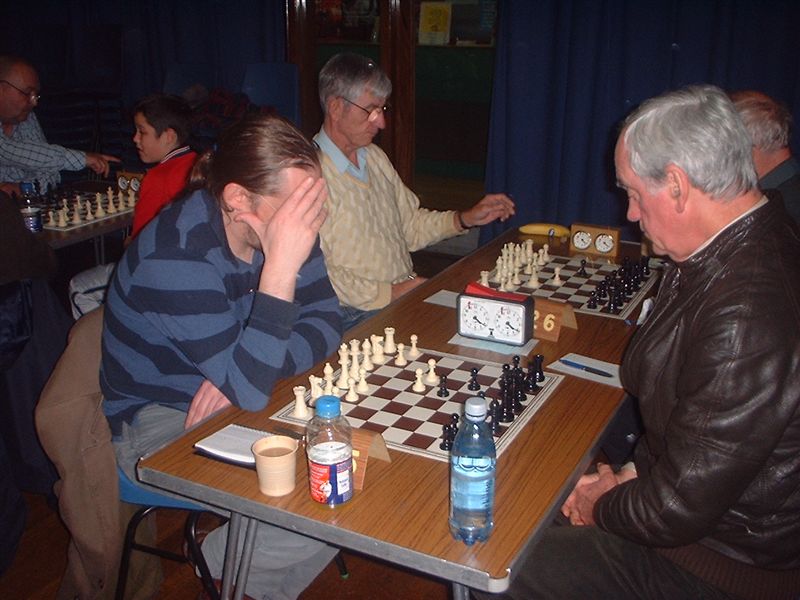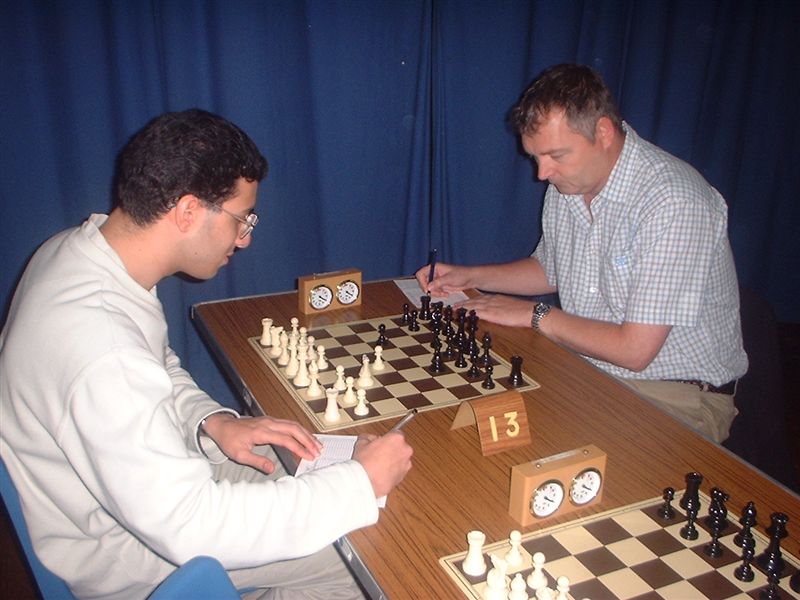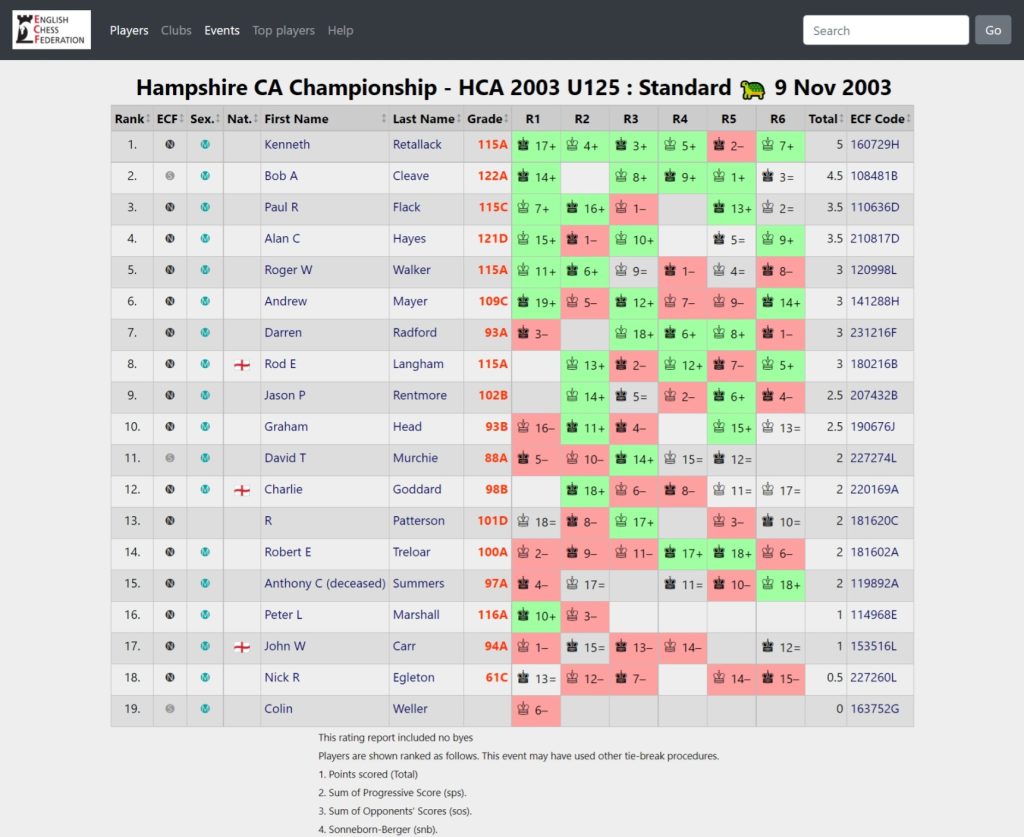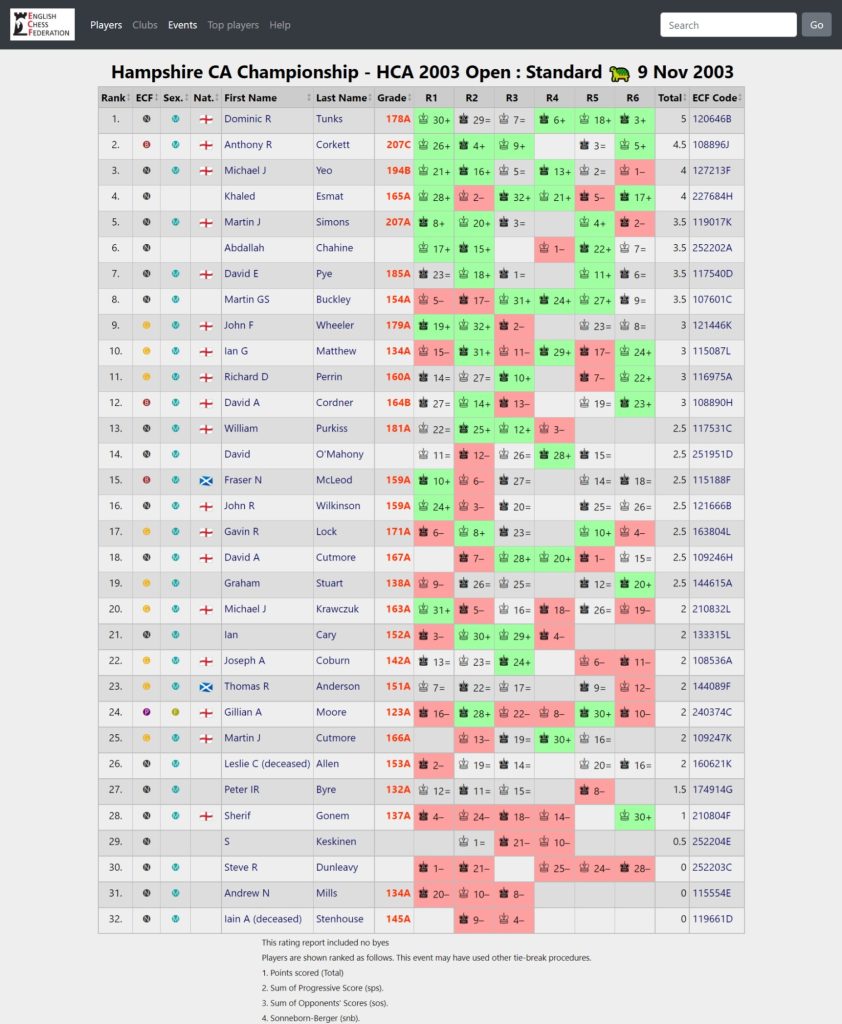The Hampshire Congress incorporating the Hampshire Individual was held at Eastleigh College the weekend of 7th November 2003. The tournament used the same format as the last few years, with an Open and under 125 graded sections. Eastleigh College proved a popular venue, with ample room and good lighting available in both sections. It was pleasing to see the total numbers increase, with 32 players in the Open and 20 in the U125. This is the first time for a number of years that the entry has exceeded 50.
The standard in the Open had slightly increased as well, with two players graded over 200 and current champion Michael Yeo also back to defend his title. The top seed was probably FM Tony Corkett, as well as being graded 207 he has also won the title four times previously. Three time winner Dominic Tunks was also playing. The other ex Hampshire champion in the field was John Wilkinson, who won the title back in 1964! John is still playing in the Southampton Chess League (2023) to a high standard for Hamble Chess club.
Any comments and analysis in the article is open to interpretation and I welcome comments, especially from the actual players.
Picture at the top is of Tony Corkett holding the Silver Rook with Peter Marshall in the foreground and John Wheeler in the background.
Note 1: This article is mainly based on the one I produced in 2003 for the original Hampshire Chess Association website, although I have expanded some parts and I am hoping that my memories of the tournament are correct.
For a list of the winners of the Hampshire Individual Championship and links to any articles I have written the table on the Hampshire Individual Championship is the best place to look. In addition, the table on the Hampshire Tournaments will detail these and any other tournament articles I have completed. Both of these are available from the menu at the top of the site as well.
Round 1
The first round is always the top versus bottom, and is therefore dominated by wins by the higher graded players. Nevertheless, there are normally some upsets and this year was no different. A.Chahine is an ungraded player, with an estimated grade of 138. This proved far too low, as can be seen from his final result. In the first round he was paired against Gavin Lock (171) and after emerging from the opening with an advantage, went on to score the full point.
I have not mentioned the other player graded over 200, Martin Simons. Martin plays in the Bournemouth league, although he has played in the Southampton Chess League in the past (but is more normally found playing in Dorset).
In the first round his was paired against Martin Buckley, who was doing very well up to move 29. But then Martin Buckley fell for first one pin and then another (although the 2nd one probably could not be avoided). The first is given below when after 29.Kg1 .. Nxg3 was played.
I should also mention that Les Allen put up a valiant fight against Tony Corkett and the position below looked very drawish until Les played 31..Nd3, rather than 31..Kf8. This allowed 32.Qe8, where another error 32..Kh7 saw Les resign after 33.Be4+ which won the Knight.
The first round of the Hampshire Congress is always a tough one, with pressure on the top players to win their games and the lower graded players knowing that they are normally playing someone graded 40+ points higher than them.
This is normally at the end of a long week at work, with another two days of chess ahead of you. It’s no wonder that when I got home I enjoyed a couple of beers, which helped me forget about the way I had been outplayed by John Wheeler in this round! Surely my remaining games would be easier!
| Player | Grade | Result | Player | Grade | Result |
|---|---|---|---|---|---|
| AR Corkett | 207 | 1 | L Allen | 153 | 0 |
| MG Buckley | 153 | 0 | M Simons | 207 | 1 |
| M Yeo | 194 | 1 | I Cary | 152 | 0 |
| T Anderson | 151 | ½ | D Pye | 185 | ½ |
| W Purkiss | 181 | ½ | J Coburn | 142 | ½ |
| JF Wheeler | 180 | 1 | G Stuart | 138 | 0 |
| DR Tunks | 178 | 1 | S Dunleavy | u | 0 |
| A Chahine | u | 1 | G Lock | 171 | 0 |
| K Esmat | 165 | 1 | S Gonem | 137 | 0 |
| P Byre | 132 | ½ | D Cordner | 164 | ½ |
| M Krawczuk | 163 | 1 | A Mills | 134 | 0 |
| I Matthew | 135 | 0 | F McLeod | 159 | 1 |
| J Wilkinson | 159 | 1 | G Moore | 123 | 0 |
| D O ‘Mahoney | u | ½ | R Perrin | 159 | ½` |
| I Stenhouse | 145 | 1 | Controller Bye | ||
| D Cutmore | 167 | ½ | Bye | ||
| M Cutmore | 166 | ½ | Bye | ||
| S Keskinen | u | ½ | Bye | � |
Round 2
The second round saw all the participants playing and there were some attractive pairings on show. The top seeds showed their class, with the top three boards winning well. Tony Corkett’s win was particularly impressive, as Khaled did not seem to play any bad moves, but was just outplayed.
I had a bit more time to look at the games being played in round two, as my game did not last that long (a reasonably short draw). As one of the lower graded players in the tournament (the average grade at this year’s Hampshire Open Congress was just over 160) it’s important to get on the scoreboard as soon as possible.
This is for two reasons, one the games don’t seem to get any easier despite your score, as can be seen by Martin Buckley being paired with Gavin Lock this round. Two, if there is an odd number of players, the lower graded player will normally get the one point bye. So as well as not playing a game, you then get an inflated score and a tough game in the following round! And you think it’s tough being one of the top players!
Anyway, the shortness of my game allowed me to look at some of the other games that were being played in a bit more detail than normal…
A Chahine’s estimated grade had been amended from 138 to a more realistic 183, which saw him paired against Fraser McLeod on board four. In a King’s Indian’s Fraser as White got the attack in first and had an overwhelming position. The problem was time, which Fraser did not have a huge amount of!
In the diagrammed position after 23…Kg8 Fraser played 24.Bxf5 rather than 24.Qe7 and although there were other chances, this was probably the move which cost Fraser the game.
Another interesting position was seen in Tom Anderson’s game against Joe Coburn. The following position was reached with Tom playing Black.
Tom played 23…Ne5, which seems OK, it threatens to double White’s f pawn by playing Nxf3. Unfortunately it allows, 24. Rxd6! which Joe saw and played (Black cannot take the Rook due to Bh7 check, picking up the Queen.)
Mind you, Black is still better in this position but the game ended in a draw, in a Queen and pawn ending. These endings are tricky, as you can see from my game against Dave Cordner in the fifth round.
What Tom missed and to be honest was spotted not by me but by Fritz, is the killing move 23…Nb2!!, which attacks the Queen and takes away the threats on h7 as the white squared Bishop is being chopped next. White’s best continuation is probably 24.Qd2 ( 24.Bh7+ Kxh7 25.Qxd5 Bxd5) 24…Nxd3 25.Ra7 Nf4 26.Rxb7 Nh3+ 27.gxh3 Qxb7] which leaves an easily won game for Black.
| Player | Grade | Result | Player | Grade | Result |
|---|---|---|---|---|---|
| K Esmat | 165 | 0 | AR Corkett | 207 | 1 |
| M Simons | 207 | 1 | M Krawczuk | 163 | 0 |
| JR Wilkinson | 159 | 0 | M Yeo | 194 | 1 |
| F McLeod | 159 | 0 | A Chahine | u | 1 |
| JF Wheeler | 180 | 1 | I Stenhouse | 145 | 0 |
| S Kesiken | u | ½ | DR Tunks | 178 | ½ |
| D Pye | 185 | 1 | D Cutmore | 167 | 0 |
| M Cutmore | 166 | 0 | W Purkiss | 181 | 1 |
| J Coburn | 142 | ½ | T Anderson | 151 | ½ |
| R Perrin | 159 | ½ | P Byre | 132 | ½ |
| D Cordner | 164 | 1 | D O’Mahoney | u | 0 |
| I Cary | 151 | 1 | S Dunleavy | u | 0 |
| L Allen | 153 | ½ | G Stuart | 138 | ½ |
| G Lock | 171 | 1 | MG Buckley | 153 | 0 |
| S Gonem | 137 | 0 | G Moore | 123 | 1 |
| A Mills | 134 | 0 | I Matthew | 135 | 1 |
Round 3
Well for some of us, this was the last round of the day, whilst the more committed (choose your own interpretation of the word) still had another game to look forward to in the evening. There were five players on maximum points but A Chahine had a half point bye in this round. This made the top pairings straightforward with Tony Corkett playing John Wheeler and Michael Yeo against Martin Simons.
So this was really a club tournament, with all four players being members at that time of the 4NCL Wessex Chess club (if you count board three, all six players are Wessex players!) Note 2)). Tony Corkett did a lot better against John Wheeler’s Petroff than I did in the first round and although personally I am not convinced that 4.a3 is the best move he did get an advantage. This was converted into the full point and with Michael Yeo and Martin Simons drawing meant he was the only player on maximum points at the end of round three.
Note 2: I am not 100% sure John played for Wessex, but this is what was written in 2003.
In fact Michael Yeo had a great chance to share the lead, as he had an excellent position against Martin Simons. In the position below Michael as white played 18.Red1 which looks a good move. More forcing and stronger though is 18.f5 Nf8 19.Nxb5+- where the knight we go to d4 and white will push his e pawn.
My game also was quite interesting, as after the opening I had a pretty lousy position, which drifted into a probably lost one. Just as my opponent looked to be building up the pressure to win on the Queenside, he allowed me counterplay against his King.
Time was ticking by though and instead of delivering the killing blow, I took a perpetual check.
| Player | Grade | Result | Player | Grade | Result |
|---|---|---|---|---|---|
| AR Corkett | 207 | 1 | JF Wheeler | 180 | 0 |
| M Yeo | 194 | ½ | M Simons | 207 | ½ |
| DR Tunks | 178 | ½ | D Pye | 185 | ½ |
| W Purkiss | 181 | 1 | D Cordner | 164 | 0 |
| I Cary | 151 | 1 | S Keskinen | u | 0 |
| T Anderson | 151 | ½ | G Lock | 171 | ½ |
| I Stenhouse | 145 | 0 | K Esmat | 165 | 1 |
| G Moore | 123 | 0 | J Coburn | 142 | 1 |
| I Matthew | 135 | 0 | R Perrin | 159 | 1 |
| P Byre | 132 | ½ | F McLeod | 159 | ½ |
| M Krawczuk | 163 | ½ | JR Wilkinson | 159 | ½ |
| G Stuart | 138 | ½ | M Cutmore | 166 | ½ |
| D O’Mahoney | u | ½ | L Allen | 153 | ½ |
| D Cutmore | 167 | 1 | S Gonem | 137 | 0 |
| MG Buckley | 153 | 1 | A Mills | 134 | 0 |
| A Chahine | u | ½ | Bye | ||
| S Dunleavy | u | 1 | Bye | � |
So, those of us with the evening bye disappeared, leaving those with more stamina to play their third game of the day. The leader board after three rounds was:
Round 3 Table
| Player | Score |
|---|---|
| Anthony Corkett | 3 |
| Bill Purkiss | 2½ |
| Michael Yeo | 2½ |
| A Chahine | 2½ |
| Dominic Tunks | 2½ |
Round 4
Out of the 32 players in the Open, only 16 decided to play in the 4th round Therefore this was a good opportunity for the players on two and a half points to join Tony Corkett (who had a bye) in the lead. The four players on two and a half were Michael Yeo, Bill Purkiss, Dominic Tunks and A Chahine.
Bill’s game against Michael was following a Michael Adams – Jeron Piket game from 1992. Michael was the first to vary and Bill drifted into a uncomfortable position. This got worse, when a bad move meant that Bill lost a piece, although he had some compensation. But in the position below, Bill has just played 24.f3 which allowed Michael to reply 24..Nxf3. The knight obviously cannot be taken and soon after this happened Bill resigned and Michael Yeo joined Tony Corkett on three and a half points from four games.
The other game between A Chahine and Dominic was a real struggle, with both players having a virtually winning position at one stage or another. In the end Dominic was victorious and joined the other two players in the lead.
One more game from this round, shows that three games in a day is sometimes one to many. Ian Cary, playing with Black against Khaled Esmat sacrificed a piece for three pawns early in the game. Black’s Queenside pawns could become dangerous later in the game (although I still think White is much better).
But Ian has just castled and allows Khaled to play 13.Bxf6, picking up the Bishop with check (Ian probably missed that it was check, as otherwise the Rook on a1 can be taken.
| Player | Grade | Result | Player | Grade | Result |
|---|---|---|---|---|---|
| W Purkiss | 181 | 0 | M Yeo | 194 | 1 |
| A Chahine | u | 0 | DR Tunks | 178 | 1 |
| K Esmat | 165 | 1 | I Cary | 151 | 0 |
| D Cutmore | 167 | 1 | M Krawczuk | 163 | 0 |
| S Kesiken | u | 0 | I Matthew | 135 | 1 |
| G Moore | 123 | 0 | MG Buckley | 153 | 1 |
| S Dunleavy | u | 0 | M Cutmore | 166 | 1 |
| S Gonem | 137 | 0 | D O’Mahoney | u | 1 |
| Everyone else | ½ | Bye |
Going into Sunday morning, three players shared the lead on three and a half points, but there was still a lot more action to happen.
Round 5
There were a few withdrawals and absentees in the fifth round, with only 29 players now in the tournament. There were two players on three and a half points and a further three players half a point back. Therefore if either Michael Yeo or Tony Corkett won, they would need to be beaten in the last round to stop them winning the Silver Rook trophy.
To keep in contention the chasing players had to ensure they won their games. Therefore it was not a surprise that the majority of the top boards were decisive, although the top board was drawn, not without drama though.
Further down, my game against David Cordner was the last to finish, using all but a few seconds of the permitted time. After having an advantage, David then outplayed me leading up to the time control (Note 3). I managed to hold onto the position though, making David find tough moves. I also started to claw back the time and was very relieved when David offered the draw (as was the controller Pat McEvoy, as he did not have to step in at the last moment).
Note 3: 40 moves in 100 minutes followed by a 20-minute quickplay finish.
In my game both players had managed to Queen a pawn.
But David was always going to win my last pawn by force, which gave him a fairly advanced pawn in the Queen ending. These endings are difficult for both sides, with Black having to make sure he does not allow White to exchange queens, which is normally by means of check. White has to stop the constant checks by the Black Queen and ensure that his last pawn is not captured.
Therefore for Black it is best to keep his King away from the White pawn, as these are the situations that normally allow the swapping of the Queens. This goes against most endings where the King needs to get close to the pawn. As mentioned, I was very pleased to draw this game and I don’t think I made any major errors in the quick-play finish. The game is captured up to move 73, but the game was probably about 100 moves in the end. It is certainly the longest game I have played up to this time.
Due to my mammoth game I did not catch much of the other games in this round. The top board was an interesting game with Michael Yeo building up a large advantage against Tony Corkett. In the position below Michael has just played 17.Be7, which allowed Tony the interesting exchange sacrifice 17…Rxf3.
This is a complex position but good play by both players resulted in the hostilities ending in the position below where progress for either side is very difficult and the game was agreed drawn.
On board two Martin Simons beat Khaled Esmat in fine style, whilst Dominic Tunks outplayed David Cutmore from a level position on board three. These games are worth playing through and I have supplied light annotations to them from the Games link.
| Player | Grade | Result | Player | Grade | Result |
|---|---|---|---|---|---|
| M Yeo | 194 | ½ | AR Corkett | 207 | ½ |
| M Simons | 207 | 1 | K Esmat | 165 | 0 |
| DR Tunks | 178 | 1 | D Cutmore | 167 | 0 |
| D Pye | 185 | 1 | R Perrin | 159 | 0 |
| J Coburn | 142 | 0 | A Chahine | u | 1 |
| JF Wheeler | 180 | ½ | T Anderson | 151 | ½ |
| G Lock | 171 | 1 | I Matthew | 135 | 0 |
| M Cutmore | 166 | ½ | J R Wilkinson | 159 | ½ |
| F McLeod | 159 | ½ | D O Mahoney | u | ½ |
| M Buckley | 153 | 1 | P Byre | 132 | 0 |
| D Cordner | 164 | ½ | G Stuart | 138 | ½ |
| L Allen | 153 | ½ | M Krawczuk | 163 | ½ |
| S Dunleavy | u | 0 | G Moore | 123 | 1 |
| S Gonem | 137 | 1 | Bye | 0 |
Going into the last round there were four players on four points from five games, Tony Corkett, Michael Yeo, Martin Simons and Dominic Tunks. Tony Corkett had the advantage of knowing that his Sum of Progressive score was the best, so with a further tie after the sixth round he would be Hampshire Champion.
Round 6
With four players in contention for the top prize, the final round was going to be very close and hard-fought. The two highest graded players were paired together on board one, as were the two previous Hampshire champions on board two – you could not ask for a better conclusion to the tournament!
Tom Anderson was having a successful, if solid Hampshire Congress, with all draws so far. Three of these games were against opponents graded from 20 to 35 points higher than him and he was probably hoping for a final win, to cap a fine tournament.
In the last round though, he played an inspired David Cordner, who showed no ill effects from his marathon games against me from the morning with a stunning sacrifice.
Tom plays 20. f4 and David snatches his chance with 20…Nf3!!, which soon leads to mate.
For the last round I was paired with Mike Krawczuk, with my second game of the day with the Black pieces. It’s a fact that in the Hampshire Congress the games just don’t get any easier!
I have to be honest and say that I did not like my position and after 10 moves in my game against Mike, I offered a draw. This was declined, not without reason, as White did have an advantage.
What was in my favour was time, as Mike was using more and more trying to find the key moves. But in doing this, he first let the position slip away and then blundered the game. He was a bit unlucky, as to get a killing move from the position did not look possible. But the problem was that in the final position White will be the exchange and a pawn down and even though he has the two Bishops he does not have much counter play.
This was therefore for me a successful Hampshire Congress, just the one loss to John Wheeler, this one win and three draws against higher graded opponents
The Hampshire Individual Champion was going to be decided on the top two boards, with the four players involved currently having four points from five games.
On board two last year’s champion Michael Yeo was playing three time champion Dominic Tunks. Michael has kindly annotated this game in full, this is especially welcome as the game did not go well for him!
Initially White had a very good position, which was probably winning, but then Michael played one bad move, which allowed Dominic to play a nice combination, netting White’s Queen.
This gave Dominic five points from six games and this meant that at the very least he would share first prize; but the board one game was key as to whether he would become Hampshire Individual Champion for the fourth time!
Before going on to this, it’s worth saying something about Dominic’s performance. This year Dominic was the 7th seed and he has not had particularly good performances in this years Southampton and Portsmouth Leagues. Despite this he scored five points from six games and played to about 200 strength (difficult to calculate as he played 3 ungraded players). So hats off to Dominic for turning in another star performance.
Anyway, onto the Tony Corkett – Martin Simons game. The turning point was in the position right, where Martin Simons declined taking the b2 pawn and instead played 17…Ne6. This allowed White to take control of the d4 square and squeeze black into an uncomfortable position.
The game eventually turned into a rook and opposite colour Bishop ending, with White a pawn up. Black’s problems were more to do with his lack of development of his Rook though, than the pawn.
The pressure was kept on by Tony Corkett and in the end Martin Simons fell into a mate in one in a hopeless position.
This meant that Tony Corkett and Dominic Tunks tied for 1st place in the Hampshire Congress with five points. The Hampshire Individual Champion was Tony Corkett, as his sum of progressive score was the superior of the two players.
So congratulations to Tony Corkett on becoming Hampshire Champion for the fifth time.
Tony annotated the game for the original article.
| Player | Grade | Result | Player | Grade | Result |
|---|---|---|---|---|---|
| AR Corkett | 207 | 1 | M Simons | 207 | 0 |
| M Yeo | 194 | 0 | DR Tunks | 178 | 1 |
| A Chahine | u | ½ | D Pye | 185 | ½ |
| JF Wheeler | 180 | ½ | M Buckley | 153 | ½ |
| G Lock | 171 | 0 | K Esmat | 165 | 1 |
| D Cutmore | 167 | ½ | F McLeod | 159 | ½ |
| D O’Mahoney | u | 1 | M Cutmore (def) | 166 | 0 |
| T Anderson | 151 | 0 | D Cordner | 164 | 1 |
| RD Perrin | 159 | 1 | J Coburn | 142 | 0 |
| JR Wilkinson | 159 | ½ | L Allen | 153 | ½ |
| M Krawczuk | 163 | 0 | G Stuart | 138 | 1 |
| I Matthew | 135 | 1 | G Moore | 123 | 0 |
| S Gonem | 137 | 1 | S Dunleavy | u | 0 |
Thanks are due to Pat McEvoy who again gave his services free and ran an extremely smooth tournament.
Final Position Summary
The prize winners of the Open Tournament were:
- 1st Tony Corkett and Dominic Tunks (5) – Silver Rook and Hampshire Individual Championship to Tony Corkett
- 3rd Martin Simons, Michael Yeo, David Pye, Khaled Esmat and Abdallah Chahine (4)
- U160 Richard Perrin (Len Walters Trophy) and Martin Buckley (3½)
- U140 Graham Stuart and Ian Matthew (Peter Marshall Cup) (3)
As the basis of this is from the ECF grading site, which does not take into account byes the rankings do not match the final real positions. But to amend this I would have to recreate the numbers for each player, which I have not done. But the table can be sorted to allow you to do this.
| No. | Name | Grade | Rd 1 | Rd 2 | Rd 3 | Rd 4 | Rd 5 | Rd 6 | Score |
|---|---|---|---|---|---|---|---|---|---|
| 1 | Dominic R Tunks | 178 | 30+ | 29= | 7= | 6+ | 18+ | 3+ | 5/6 |
| 2 | Anthony R Corkett | 207 | 26+ | 4+ | 9+ | =bye | 3= | 5+ | 5/6 |
| 3 | Michael J Yeo | 194 | 21+ | 16+ | 5= | 13+ | 2= | 1– | 4/6 |
| 4 | Khaled Esmat | 165 | 28+ | 2– | 32+ | 21+ | 5– | 17+ | 4/6 |
| 5 | Martin J Simons | 207 | 8+ | 20+ | 3= | =bye | 4+ | 2– | 4/6 |
| 6 | Abdallah Chahine | u | 17+ | 15+ | =bye | 1– | 22+ | 7= | 4/6 |
| 7 | David E Pye | 185 | 23= | 18+ | 1= | =bye | 11+ | 6= | 4/6 |
| 8 | Martin GS Buckley | 154 | 5– | 17– | 31+ | 24+ | 27+ | 9= | 3.5/6 |
| 9 | John F Wheeler | 179 | 19+ | 32+ | 2– | =bye | 23= | 8= | 3.5/6 |
| 10 | Ian G Matthew | 134 | 15– | 31+ | 11– | 29+ | 17– | 24+ | 3/6 |
| 11 | Richard D Perrin | 160 | 14= | 27= | 10+ | =bye | 7– | 22+ | 3.5/6 |
| 12 | David A Cordner | 164 | 27= | 14+ | 13– | =bye | 19= | 23+ | 3.5/6 |
| 13 | William Purkiss | 181 | 22= | 25+ | 12+ | 3– | 2.5/4 | ||
| 14 | David O’Mahony | u | 11= | 12– | 26= | 28+ | 15= | 2.5/5 | |
| 15 | Fraser N McLeod | 159 | 10+ | 6– | 27= | =bye | 14= | 18= | 3/6 |
| 16 | John R Wilkinson | 159 | 24+ | 3– | 20= | =bye | 25= | 26= | 3/6 |
| 17 | Gavin R Lock | 171 | 6– | 8+ | 23= | =bye | 10+ | 4– | 3/6 |
| 18 | David A Cutmore | 167 | =bye | 7– | 28+ | 20+ | 1– | 15= | 3/6 |
| 19 | Graham Stuart | 138 | 9– | 26= | 25= | =bye | 12= | 20+ | 3/6 |
| 20 | Michael J Krawczuk | 163 | 31+ | 5– | 16= | 18– | 26= | 19– | 2/6 |
| 21 | Ian Cary | 152 | 3– | 30+ | 29+ | 4– | 2/4 | ||
| 22 | Joseph A Coburn | 142 | 13= | 23= | 24+ | =bye | 6– | 11– | 2.5/6 |
| 23 | Thomas R Anderson | 151 | 7= | 22= | 17= | =bye | 9= | 12– | 2.5/6 |
| 24 | Gillian A Moore | 123 | 16– | 28+ | 22– | 8– | 30+ | 10– | 2/6 |
| 25 | Martin J Cutmore | 166 | =bye | 13– | 19= | 30+ | 16= | 2.5/5 | |
| 26 | Leslie C Allen | 153 | 2– | 19= | 14= | =bye | 20= | 16= | 2.5/6 |
| 27 | Peter IR Byre | 132 | 12= | 11= | 15= | =bye | 8– | 2/5 | |
| 28 | Sherif Gonem | 137 | 4– | 24– | 18– | 14– | +bye | 30+ | 2/6 |
| 29 | S Keskinen | u | =bye | 1= | 21– | 10– | 1/4 | ||
| 30 | Steve R Dunleavy | u | 1– | 21– | +bye | 25– | 24– | 28– | 1/6 |
| 31 | Andrew N Mills | 134 | 20– | 10– | 8– | =bye | 0.5/4 | ||
| 32 | Iain A Stenhouse | 145 | +bye | 9– | 4– | =bye | 1.5/4 |
U125 Tournament
Alongside the Open an Under 125 Tournament was held. This was won by ex Hampshire President and Treasurer Ken Retallack whilst Winchester’s Bob Cleave was 2nd half a point behind.
- 1st Ken Retallack (5)
- 2nd Bob Cleave (4½)
- 3rd Alan Hayes, Paul Flack and Rod Langham (4)
- U100 Darren Radford (4)
Games
All the games from the Open Congress are available for download or to be played through online.
Gallery
Photographs from the 2003 Hampshire Chess Congress below and in the Hampshire Chess Gallery.
